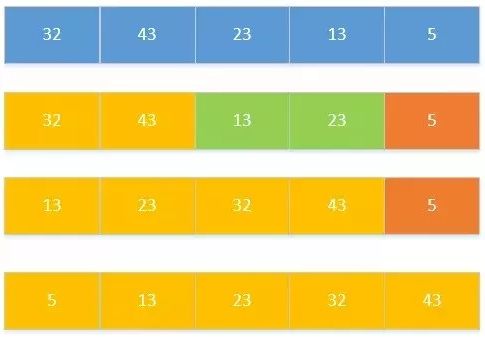参考文章:https://mp.weixin.qq.com/s/VjqZNPg6dAEReAzqZcb_yw
原文链接:www.jianshu.com/p/5e171281a387
7.归并排序 —— 速度仅次于快排,内存少的时候使用,可以进行并行计算的时候使用。
-
选择相邻两个数组成一个有序序列。
-
选择相邻的两个有序序列组成一个有序序列。
-
重复第二步,直到全部组成一个有序序列。

public static void mergeSort(int[] numbers, int left, int right) { int t = 1;// 每组元素个数 int size = right - left + 1; while (t < size) { int s = t;// 本次循环每组元素个数 t = 2 * s; int i = left; while (i + (t - 1) < size) { merge(numbers, i, i + (s - 1), i + (t - 1)); i += t; } if (i + (s - 1) < right) merge(numbers, i, i + (s - 1), right); } } private static void merge(int[] data, int p, int q, int r) { int[] B = new int[data.length]; int s = p; int t = q + 1; int k = p; while (s <= q && t <= r) { if (data[s] <= data[t]) { B[k] = data[s]; s++; } else { B[k] = data[t]; t++; } k++; } if (s == q + 1) B[k++] = data[t++]; else B[k++] = data[s++]; for (int i = p; i <= r; i++) data[i] = B[i]; }
8.基数排序 —— 用于大量数,很长的数进行排序时。
-
将所有的数的个位数取出,按照个位数进行排序,构成一个序列。
-
将新构成的所有的数的十位数取出,按照十位数进行排序,构成一个序列。

public void sort(int[] array) { //首先确定排序的趟数; int max = array[0]; for (int i = 1; i < array.length; i++) { if (array[i] > max) { max = array[i]; } } int time = 0; //判断位数; while (max > 0) { max /= 10; time++; } //建立10个队列; List<ArrayList> queue = new ArrayList<ArrayList>(); for (int i = 0; i < 10; i++) { ArrayList<Integer> queue1 = new ArrayList<Integer>(); queue.add(queue1); } //进行time次分配和收集; for (int i = 0; i < time; i++) { //分配数组元素; for (int j = 0; j < array.length; j++) { //得到数字的第time+1位数; int x = array[j] % (int) Math.pow(10, i + 1) / (int) Math.pow(10, i); ArrayList<Integer> queue2 = queue.get(x); queue2.add(array[j]); queue.set(x, queue2); } int count = 0;//元素计数器; //收集队列元素; for (int k = 0; k < 10; k++) { while (queue.get(k).size() > 0) { ArrayList<Integer> queue3 = queue.get(k); array[count] = queue3.get(0); queue3.remove(0); count++; } } } }